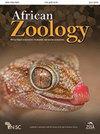寄主分散对全科和专科外寄生虫基因流和遗传多样性的影响
IF 0.5
4区 生物学
Q4 ZOOLOGY
引用次数: 5
摘要
寄生虫物种内的传播和随后的基因流动是寄生虫生活史、宿主生活史和非生物环境因素之间复杂相互作用的结果。为了深入了解寄生虫传播的驱动因素,将来自六种南部非洲多面手寄生虫物种(包括跳蚤、螨虫和蜱虫)的COI mtDNA基因数据与来自同一地理区域的四种专业物种进行了比较。以Amblyomma hebraeum、Hyalomma truncatum和H.rufipes为代表的普通蜱物种都暂时出现在高度流动的有蹄类宿主上,表现出高水平的单倍型遗传多样性和高水平的扩散,种内全球Fst(种群分化指数)的平均值为0.27(±0.13),Listropcillus agrippinae和Chiastopcillus rossi,以及一种在宿主上都是半永久性的、仅限于流动性较低的宿主物种Laelaps muricola,表现出类似的高水平遗传多样性,但Fst值为0.67(±0.11)的中等平均值,Hoploplera patersoni和P.arvicanthis记录了地理采样点之间最低水平的遗传多样性和低水平的基因流动,平均Fst值为0.95(±0.05)。这项研究为专家广义变异假说(SGVH)提供了有力的支持,并强调了宿主扩散和寄生虫对宿主的专门化在传播和体外寄生虫的进化。本文章由计算机程序翻译,如有差异,请以英文原文为准。
The Influence of Host Dispersal on the Gene Flow and Genetic Diversity of Generalist and Specialist Ectoparasites‡
The dispersal and subsequent gene flow within parasite species is the result of a complex interaction between parasite life history, host life history and abiotic environmental factors. To gain more insights into the drivers responsible for parasite dispersal, COI mtDNA genetic data derived from six southern African generalist parasite species, including fleas, mites and ticks were compared with four specialist species from the same geographic region. Generalist tick species represented by Amblyomma hebraeum, Hyalomma truncatum and H. rufipes all occur temporarily on highly mobile ungulate hosts and showed high levels of haplotypic genetic diversity and high levels of dispersal with an average intraspecific global Fst (population differentiation index) value of 0.27 (±0.13). Generalist parasites, such as fleas, Listropsylla agrippinae and Chiastopsylla rossi, and one mite species, Laelaps muricola, that are all semi-permanent on the host and restricted to less mobile hosts species, showed a similar high level of genetic diversity, but an intermediate average Fst value of 0.67 (±0.11). Highly specialised semi-permanent parasites, such as the mite L. giganteus and the permanent lice Polyplax praomydis, Hoplopleura patersoni and P. arvicanthis recorded the lowest level of genetic diversity and a low level of gene flow among geographic sampling localities with an average Fst value of 0.95 (±0.05). This study provides strong support for the Specialist Generalist Variation Hypothesis (SGVH) and highlights the role that host dispersal and host specialisation by parasites play in the dispersal and evolution of ectoparasites.
求助全文
通过发布文献求助,成功后即可免费获取论文全文。
去求助
来源期刊

African Zoology
生物-动物学
CiteScore
2.60
自引率
9.10%
发文量
18
审稿时长
>12 weeks
期刊介绍:
African Zoology , a peer-reviewed research journal, publishes original scientific contributions and critical reviews that focus principally on African fauna in terrestrial, freshwater, and marine ecosystems. Research from other regions that advances practical and theoretical aspects of zoology will be considered. Rigorous question-driven research in all aspects of zoology will take precedence over descriptive research. The Journal publishes full-length papers, critical reviews, short communications, letters to the editors as well as book reviews. Contributions based on purely observational, descriptive or anecdotal data will not be considered.
The Journal is produced by NISC in association with the Zoological Society of South Africa (ZSSA). Acceptance of papers is the responsibility of the Editors-in-Chief in consultation with the Editors and members of the Editorial Advisory Board. All views expressed are those of the author and not necessarily those of the Editors or the Department.
 求助内容:
求助内容: 应助结果提醒方式:
应助结果提醒方式:


